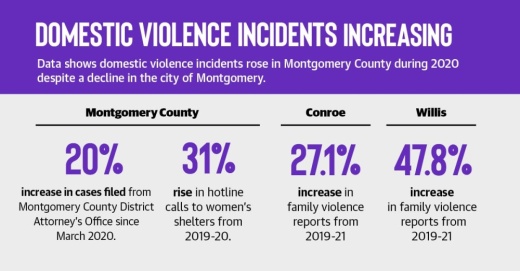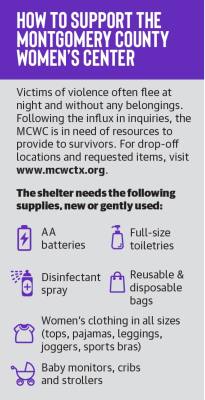Echo Hutson, chief prosecutor of the Domestic Violence Division at the Montgomery County District Attorney’s Office, said in Montgomery County, the number of filed domestic violence-related cases increased an average of 20% each month starting in March 2020 from the previous year. The rise in cases remained at a steady rate through 2021, with some months reaching as high as a 50% increase.
“Last year in 2021, after Montgomery County wasn’t locked down anymore and we were trying to get back to normal, ... I went and pulled all the stats again and went through all of the stats,” Hutson said. “And we had the same 20% increase all the way through 2021.”
Family violence reports have fluctuated among municipalities in north Montgomery County with the cities of Conroe and Willis seeing a steady increase from 2019-21 while the city of Montgomery saw numbers drop during the pandemic, according to the Conroe Police Department and the Texas Department of Public Safety’s Uniform Crime Reporting system.
Willis Police Chief James Nowak said in an email he believes the pandemic has led to an increase of family violence cases statewide because of people being home more due to lost jobs, reduced hours or remote work.
While family violence crimes often go underreported, calls to hotlines have increased during the pandemic, according to Molly Boyles, director of public policy for the Texas Council on Family Violence—a nonprofit coalition that aims to prevent and respond to family violence.
Boyles said cases could be underreported because survivors could be calling places other than law enforcement—such as shelters or hotlines—for help or staying home longer during the pandemic.
“Survivors were forced to probably stay in their home a bit longer, partially due to the health concerns associated with the pandemic,” Boyles said.
Boyles said family violence reports also may have escalated with survivors having greater access to virtual resources. This access includes a 750% increase in available virtual services from 2019-20.
Because local and county incidents have not fallen to pre-pandemic numbers, area women’s centers continue to juggle the demand in services as well.
Underreported incidents
Willis reported a 47.76% increase in family violence cases from 2019-21, rising from 67 cases reported annually to 99 cases, Nowak said. Similarly, Conroe reported a 27.13% increase from 2019-21, going from 446 reports annually to 567, according to data from the city. The Conroe Police Department declined to comment on the data.
On the contrary, the city of Montgomery saw cases decrease from 16 in 2019 to 10 in 2020 and 2021, according to the DPS database. The Montgomery Police Department did not respond to requests for comment by press time. Despite increased reports by some entities, experts said cases are underreported.
According to a criminal victimization survey released by the U.S. Department of Justice in October, 52% of victims of domestic violence reported the crime to police in 2019. In 2020, 41% of victims reported the crime.
“Some people just don’t report what could be classified as family violence,” Nowak said. “The victim may not think that a crime occurred, or if he or she does, doesn’t want to get the offender in trouble.”
While Texas officers are required to file a report for all family violence incidents, the largest issue when determining the accurate number of assaults is victims often do not make themselves known or report every incident to law enforcement, according to Hutson.
“Seventy-eight percent of the calls [to law enforcement] come from people who are not the victim. They come from family, neighbors, friends, co-workers,” Hutson said. “When victims do call themselves, the vast majority of it is in the moment of crisis when they think they’re either not going to make it out alive or they’re going to be seriously hurt or injured.”
Hutson said victims are more likely to reach out to local support systems, such as the Montgomery County Women’s Center. Ten of the 13 law enforcement agencies in Montgomery County provided family violence reports to DPS. According to the data, there were 2,961 reported incidents of family violence in Montgomery County in 2019. However, according to Hutson, there were 49,618 hotline calls to MCWC.
In 2020, the incidents increased roughly 7%, while hotline calls increased 31%. In 2021, incidents and hotline calls were 6.6% and 7% over 2019, respectively.
“I think [we need] education, awareness, understanding and also for the community [to understand] that we’re talking about 1 in 3 women,” Hutson said. “It’s so prevalent. It’s everywhere, but it’s behind closed doors.”
Center services strained
On Sept. 10, 2020, 93% of identified domestic violence programs in Texas participated in a one-day national count of domestic violence services conducted by the National Network to End Domestic Violence. The national count found 948 requests for services on that day were unmet due to a lack of resources.
Both the MCWC and Houston Area Women’s Center—which often work together to place victims in the Houston region—continued to see increased inquiries and strained resources through 2021.
Chau Nguyen, chief public strategies officer for the HAWC, said the center saw roughly a 15% increase in hotline calls from 2019 to 2020 and an additional 20% increase from 2020 to 2021.
Nguyen said the HAWC has a 120-bed operation, and despite being the largest shelter provider in the Houston region, the center occasionally turns people away.
“On any given night, our shelter beds are full. There is a large demand for emergency housing,” Nguyen said. “Sometimes we have to turn away people.”
Legislation aimed to help victims
According to the Texas Council on Family Violence, the 87th Texas Legislature passed five bills that benefit victims of domestic and family violence. Hutson said House Bill 766 is significant because it improves the immediate safety of a victim.
Judges may issue conditions of bonds to protect victims from a person arrested for domestic violence, and prior to HB 766, law enforcement officers were unable to verify the conditions of bonds in the Texas Crime Information Center, meaning they generally could not enforce them. As a result, victims, law enforcement and the community remained at risk, and offenders were often not held accountable if they violate conditions of bonds.
The bill, which went into effect Jan. 1, requires the sheriff to enter the conditions of bonds into the information center so they are accessible and verifiable by law enforcement.
In addition, $65.3 million in state funding was allocated for core family violence services in 2022-23. The Texas Health and Human Services Commission’s Family Violence Program will use the funds to provide comprehensive services to family violence centers, which are in most counties in Texas, including hotlines, advocacy, shelter and counseling services.
Additional pieces of legislation were passed to help survivors escape abusive situations by removing the financial barriers the victim may face.
“What these types of bills do for victims is they make it easier to separate themselves from the abuser,” Hutson said. “I’m so glad to see that our Legislature is really paying attention.”








